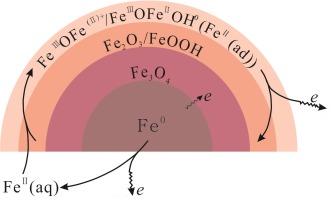Chemosphere ( IF 8.8 ) Pub Date : 2018-03-22 , DOI: 10.1016/j.chemosphere.2018.03.148 Chenzi Xu , Xiumei Wang , Yi An , Junjie Yue , Ruiling Zhang

|
The mechanism of electron transmission in combined nanoiron-bacteria denitrification cannot be explained by the classic model, in which an Fe0-H2-nitrate transferring chain is proposed. In this study, we used characteristic techniques and electrochemical analysis to investigate the necessity of molecular hydrogen for the combined denitrifying system using commercial nanoiron with Alcaligenes eutrophus, and to analyze its potential electron donor. Based on our results, nitrate removal and its by-products (NO2- and NH4+) generation was not significantly affected by residual H2 gas, indicating that H2 was not necessary for hydrogenotrophic denitrification. As to the potential electron donor analysis, nanoscale zero-valent iron did not appear to be the electron donor due to its high level of toxicity (83% mortality using nanoiron versus 36% in the control cells). In addition, when iron oxides (Fe3O4, Fe2O3 and FeOOH on the nanoiron surface) and free ferrous ions [Fe2+(aq)] were present alone, they were not utilized by the bacteria to degrade nitrate. According to the results of electrochemical analysis, adsorbed ferrous iron [Fe2+(ad)] on ferric oxides might be the electron donor in this kind of nitrate removal.
中文翻译:

纳米铁支持的氢营养性反硝化的潜在电子供体:H 2气体,Fe 0,氧化亚铁,Fe 2+(aq)或Fe 2+(ad)?
经典模型无法解释纳米铁-细菌联合反硝化过程中的电子传输机理,该模型提出了Fe 0 -H 2-硝酸根转移链。在这项研究中,我们使用特征技术和电化学分析来研究分子氢对于使用商业纳米铁与嗜碱碱生物的联合反硝化系统的必要性,并分析其潜在的电子给体。根据我们的结果,硝酸盐去除和其副产物(NO 2 -和NH 4 +)的生成没有显著由残余ħ影响2气,其中H 2氢营养反硝化不是必需的。至于潜在的电子给体分析,由于其高水平的毒性(使用纳米铁的死亡率为83%,而对照细胞为36%),因此纳米级零价铁似乎不是电子给体。另外,当单独存在氧化铁(纳米铁表面上的Fe 3 O 4,Fe 2 O 3和FeOOH)和游离亚铁离子[Fe 2+(aq)]时,细菌不会利用它们来降解硝酸盐。根据电化学分析的结果,三氧化二铁上吸附的亚铁[Fe 2+(ad)]可能是这种硝酸盐去除的电子给体。



























 京公网安备 11010802027423号
京公网安备 11010802027423号